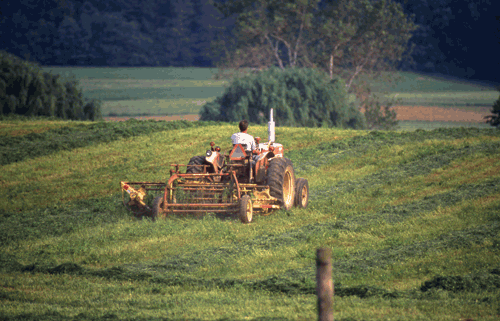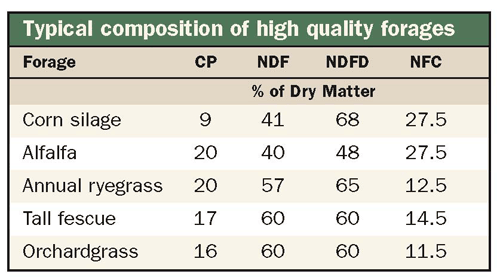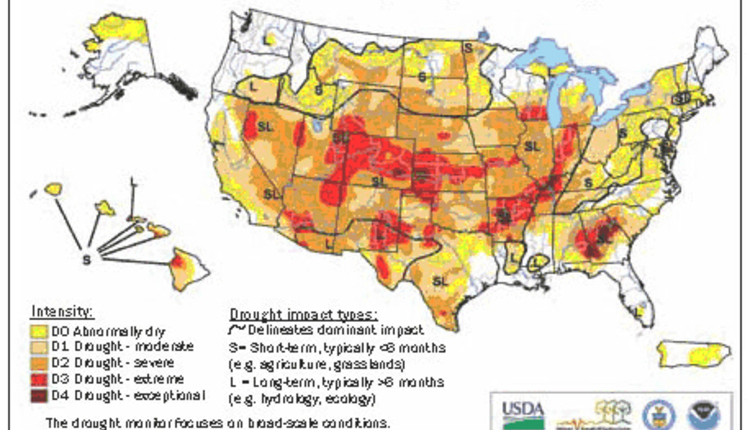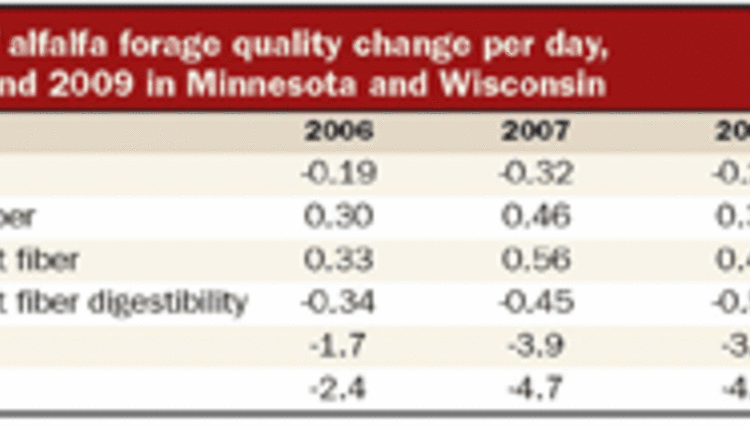The author is extension forage agronomist, University of Wisconsin, Madison.

When adding grass to forage stands, try to seed forage stands
that will contain 30 to 40 percent grass offset by 60 to 70 percent alfalfa.
Generally, dairymen and their nutritionists have perceived grasses to be too high in fiber to feed to high-producing dairy cows. But growing knowledge of digestible fiber has taught us grass is actually more digestible than alfalfa. There are two primary reasons for the new found interest in grass: agronomic and nutritional.
Agronomic reasons for grass:
Three potential approaches
One approach is to replace alfalfa with an equal amount of grass. This boosts the total fiber content of the ration. If dietary levels of NDF are high enough to limit feed intake by rumen fill, the cows fed the grass-based diets typically consume less dry matter and produce less milk than those fed an equivalent amount of alfalfa.
A second approach is to balance for an equal level of fiber. Results from experiments designed this way usually find that milk yield and intake of grass-based diets are similar to alfalfa control diets. When grasses are used to replace an equivalent amount of NDF as contained in alfalfa, forage to concentrate ratios of the diets change. These experiments clearly show that grasses can be used in diets for high-producing cows but with higher concentrate levels.
A third, and newer, approach is to use grass as a source of digestible fiber. Grass at early maturity contains more NDF than corn silage or alfalfa but the fiber is more digestible than alfalfa NDF. In addition, early maturity grasses contain lower levels of NFC relative to alfalfa or corn silage, and equal or less crude protein than alfalfa forage as shown in the table.
Diets formulated with high-quality corn silage are often marginal in fiber and high in NFC content. It then becomes necessary to incorporate feeds that have highly digestible yet contain relatively low amounts of NFC and high amounts of digestible fiber. As alfalfa is brought into high corn silage diets, often the proportion of digested energy from fiber does not change and the proportion of rapidly fermented energy only shifts slightly from NFC to digestible protein.
Nutritionists sometimes add as much as 2 to 4 pounds of straw to corn silage based diets to raise the proportion of dietary fiber. Adding straw increases the total fiber content of the diet but drops the digestible energy intake because it is poorly digested and contributes significantly to rumen fill. Grasses may be a better choice to incorporate into high-NFC/low-fiber diets because unlike straw, the fiber in grasses is more digestible than fiber in corn silage, alfalfa or wheat straw.
Replacing part of the corn silage and alfalfa with high-quality grass fiber could shift the proportion of fermented energy from NFC to NDF while not reducing the overall digestibility of the diet. This shift in fermentable components would be expected to provide a more steady supply of fermentable substrate to rumen microbes. This, in turn, could help stabilize the production of rumen acids and minimize the occurrence of ruminal acidosis.
Initial trials we have run have indicated that we could maintain high levels of milk production when replacing a portion of the corn silage and alfalfa with grass silage, even though dietary NDF increased slightly.
The key to managing alfalfa-grass mixtures for high-quality dairy forage is to maintain forage stands that contain about 30 to 40 percent grass. When the composition of the stand is in this range, nitrogen fixation from legumes can meet the needs of the grass species, and fiber content of the mixture is still acceptable.

Information on maturity and seasonal growth distribution are available on my website; select "grasses" and then "historical information on grass yield trials."
Click here to return to the Crops & Forages E-Sources
100510_337

When adding grass to forage stands, try to seed forage stands
that will contain 30 to 40 percent grass offset by 60 to 70 percent alfalfa.
Generally, dairymen and their nutritionists have perceived grasses to be too high in fiber to feed to high-producing dairy cows. But growing knowledge of digestible fiber has taught us grass is actually more digestible than alfalfa. There are two primary reasons for the new found interest in grass: agronomic and nutritional.
Agronomic reasons for grass:
- Greater seeding year yields - some grasses, such as Italian ryegrass, will establish faster than the alfalfa and produce more total forage yield in a seeding year than alfalfa alone.
- Wider harvest window on second and later cuttings - many grasses head little or not at all after first cutting. Therefore, grass regrowth is primarily leaves which change little in quality over 7 to 10 days around harvest time.
- Faster drying - 30 to 40 percent grass with alfalfa dries faster than either pure alfalfa or pure grass.
- Less winter kill or injury to the alfalfa stand might occur- some grasses will survive standing water and/or ice in low spots of field better than alfalfa. Beware that some varieties of orchardgrass and tall fescue are not as winter hardy as others and will die before alfalfa.
- Ability to apply manure to stands with less traffic damage and stand loss - grasses suffer less traffic damage than alfalfa.
- Grass/alfalfa mixtures have higher total fiber than alfalfa alone.
- The fiber of grasses is more digestible than alfalfa's fiber.
- Potential to reduce NFC (nonfiber carbohydrates) in dairy rations - today's greater use of corn silage in dairy rations, which is excellent forage for high-producing cows, has nutritional limitations because it is low in protein and high in fermentable carbohydrate (starch). Lameness in dairy cattle has risen dramatically in the Midwest in recent years . . . reaching levels of 20 to 25 percent in all dairy cattle. One of the major contributors to this situation has been formulation of high-starch, low-fiber diets, reports University of Wisconsin researchers.
Three potential approaches
One approach is to replace alfalfa with an equal amount of grass. This boosts the total fiber content of the ration. If dietary levels of NDF are high enough to limit feed intake by rumen fill, the cows fed the grass-based diets typically consume less dry matter and produce less milk than those fed an equivalent amount of alfalfa.
A second approach is to balance for an equal level of fiber. Results from experiments designed this way usually find that milk yield and intake of grass-based diets are similar to alfalfa control diets. When grasses are used to replace an equivalent amount of NDF as contained in alfalfa, forage to concentrate ratios of the diets change. These experiments clearly show that grasses can be used in diets for high-producing cows but with higher concentrate levels.
A third, and newer, approach is to use grass as a source of digestible fiber. Grass at early maturity contains more NDF than corn silage or alfalfa but the fiber is more digestible than alfalfa NDF. In addition, early maturity grasses contain lower levels of NFC relative to alfalfa or corn silage, and equal or less crude protein than alfalfa forage as shown in the table.
Diets formulated with high-quality corn silage are often marginal in fiber and high in NFC content. It then becomes necessary to incorporate feeds that have highly digestible yet contain relatively low amounts of NFC and high amounts of digestible fiber. As alfalfa is brought into high corn silage diets, often the proportion of digested energy from fiber does not change and the proportion of rapidly fermented energy only shifts slightly from NFC to digestible protein.
Nutritionists sometimes add as much as 2 to 4 pounds of straw to corn silage based diets to raise the proportion of dietary fiber. Adding straw increases the total fiber content of the diet but drops the digestible energy intake because it is poorly digested and contributes significantly to rumen fill. Grasses may be a better choice to incorporate into high-NFC/low-fiber diets because unlike straw, the fiber in grasses is more digestible than fiber in corn silage, alfalfa or wheat straw.
Replacing part of the corn silage and alfalfa with high-quality grass fiber could shift the proportion of fermented energy from NFC to NDF while not reducing the overall digestibility of the diet. This shift in fermentable components would be expected to provide a more steady supply of fermentable substrate to rumen microbes. This, in turn, could help stabilize the production of rumen acids and minimize the occurrence of ruminal acidosis.
Initial trials we have run have indicated that we could maintain high levels of milk production when replacing a portion of the corn silage and alfalfa with grass silage, even though dietary NDF increased slightly.
The key to managing alfalfa-grass mixtures for high-quality dairy forage is to maintain forage stands that contain about 30 to 40 percent grass. When the composition of the stand is in this range, nitrogen fixation from legumes can meet the needs of the grass species, and fiber content of the mixture is still acceptable.

Information on maturity and seasonal growth distribution are available on my website; select "grasses" and then "historical information on grass yield trials."
100510_337











